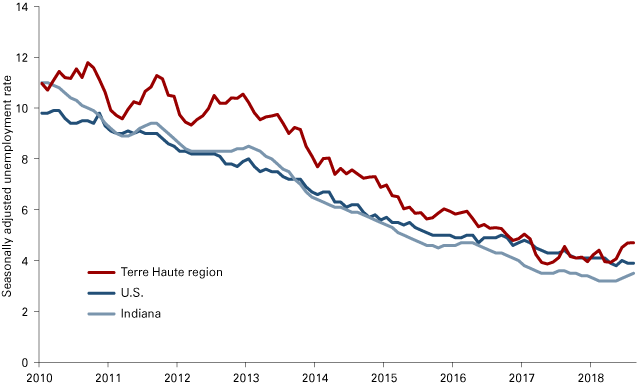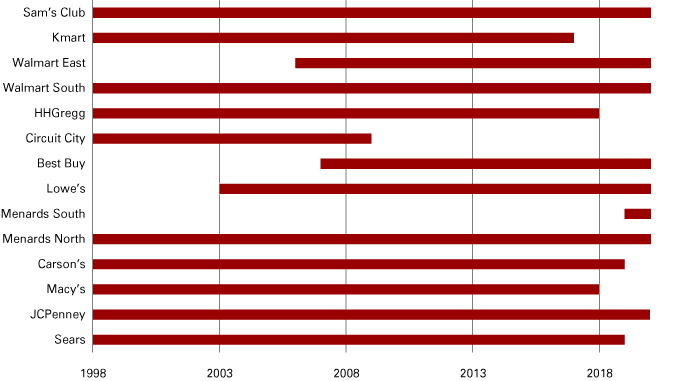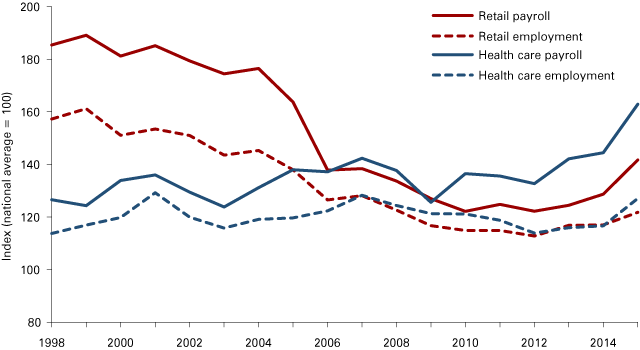Terre Haute forecast 2019

Associate Professor of Economics, Rose-Hulman Institute of Technology

Professor of Economics, Indiana State University
If construction cranes were emblematic of the Terre Haute regional economy last year, this year a more appropriate symbol might be “for rent” signs. Low occupancy rates at new multi-unit residential developments downtown, along with continuing storefront vacancies at newer downtown retail locations, have blunted some of the momentum that was visible in the local economy last year at this time. Moreover, the national trends in the retail sector have affected Terre Haute disproportionately owing to the community’s retail-intensive economy.
That being said, there are corresponding bright spots that continue to offer promise for the regional economy. The labor market remains relatively strong, there are a few notable positive signs in local manufacturing, and some major capital projects are injecting vital new investment into the area. Meanwhile, the national trend toward the centralization of health care services has boosted Terre Haute employment. Taken as a whole, however, our sense is that the economic outlook for the area is decidedly mixed.
Riding the national wave
As is true for most of the country, employment news is mostly good, although there are a few ominous clouds on the region’s horizon. The slight rise in the region’s seasonally adjusted unemployment rate (see Figure 1) probably has more to do with the recent re-entry of people into the local job market than significant new unemployment. Since the spring of 2016, there has been a remarkable uptick in the labor force, which has grown by about 1,400 people and stood at about 78,700 in August. While this is still lower than the steady average of 80,000 to 82,000 that characterized the region’s labor market for about 10 years prior to 2010, it is a marked improvement from the post-recession low of 77,300.
Figure 1: Seasonally adjusted unemployment rates, January 2010 to August 2018

Source: U.S. Bureau of Labor Statistics and authors’ calculations
Since the area’s population has not been expanding, we suspect that this growth in the labor force is mainly due to existing residents responding to the relatively strong economy and re-entering the job market. As they do, however, they are joining a pool of job seekers that is being augmented by notable workforce reductions at Sony and, more recently, Alorica, which in late October announced its intention to close its Terre Haute facility by the end of the year, a loss of about 200 jobs.
Against these ongoing and recent losses are a few gains. The fiber cement siding maker Allura has reopened its 438,000-square-foot plant in the southern Vigo County industrial park, adding about 60 jobs. On the medium-term horizon, there is hope that Saturn Petcare’s acquisition of the old Pfizer facility will eventually add 200 new jobs starting in late 2019 or (more probably) early 2020. More recently, Hearthside Food purchased the former Kellogg plant in Seelyville and announced its intention to reopen the facility, albeit with unspecified job impacts. These gains for the local economy come on the heels of the good news last year about Select Genetics on the south side of Terre Haute and Pyrolyx on the north side—new ventures that promise to generate about 150 new jobs.
In discussions of the local labor market, one often hears that “everyone who wants a job can get a job” in the current economy. That seems right given current tightness in the labor market, but recent announcements and a review of the area’s labor market history also suggest that local leaders should be wary of how quickly the employment landscape can change. At present, the region appears to have touched a lower bound of unemployment—new demand would likely be met by what appears to be a fairly elastic supply. Despite frequently heard comments about difficulties in filling job openings for skilled positions, recent activity suggests that new ventures can draw from a reasonably deep pool of talent.
The decline of brick-and-mortar retail
Since the dawn of the interstate era and the advent of malls and other concentrated retail establishments, Terre Haute has benefitted from being at the center of a largely empty 50-mile radius. If you lived 50 or fewer miles in almost any direction, your nearest mall, nearest Supercenter, nearest warehouse store, nearest electronics store, nearest full-line hardware store/lumberyard, or nearest big-box anything was in Terre Haute.
Aside from groceries and hardware/lumber, brick-and-mortar retail has been fully and completely disrupted by e-retailers. While some big-box retailers have thrived (hardware/lumberyards), most are in decline. Terre Haute’s big-box retailers hit peak density in 2007-2008 (see Figure 2).
Figure 2: Tracking major Terre Haute retailers

Source: Authors’ calculations
The closure of Sears places Honey Creek Mall in the precarious position of having three of its four anchor stores shuttered in recent years, a situation that is mirrored in many places around the country. While recent entries/expansions into the local grocery market have made it increasingly competitive, and while a new Menards in southern Vigo County promises to do the same to the home improvement sector, outside those sectors, brick-and-mortar retail is declining.
The impact on Terre Haute has been dramatic. By indexing a sector’s share of employment and payroll as a percentage of total employment and payroll to national average measures for the same ratios, one can get a good sense of the relative importance of a sector (see Figure 3). In this graphic, a value of 100 implies that the relative importance of a sector in terms of employment or payroll is average compared to the same measures for the national economy. In 1998, the area had a 60 percent higher-than-average representation of retail employment and 90 percent higher-than-average representation of retail payroll. Both have been in rapid decline since, and the slight rebound in recent years probably will not last. (The data are only available through 2015.)
Figure 3: Importance of the retail and health care sectors

Source: Authors’ calculations
The early 2018 closure of two of the Honey Creek Mall’s anchors—Carson’s and Macy’s—and the late 2018 closure of Sears likely renders Honey Creek Mall unviable as a retail center of any particular importance. Its only remaining anchor is JCPenney, a company that has lost 98 percent of its market value since 2007. This phenomenon is not confined to Terre Haute, but it will be felt disproportionately in Terre Haute as retail has been a larger-than-typical engine of economic activity.
The rise of health care
Not all disruptions have been bad for the city. While the impact of medical specialization, outpatient surgery centers, etc., has decimated rural hospitals, it has greatly enhanced the prominence of regional health care centers—and Terre Haute is one such center. While not on par with major urban centers, such as Indianapolis, Terre Haute is a significant center of health care activity. Using the same indexed measures of the relative importance of a sector just presented for retail, Figure 3 shows that health care is growing in Terre Haute faster than it is growing nationally. From 10 percent more important than the national average in employment and 26 percent in payroll in 1998, those indexes have risen such that health care employment and payroll are now 27 percent and 63 percent more important than the national average, respectively.
Other sectors are mixed
Enrollment at both major secondary educational institutions in the area—Indiana State University (ISU) and Rose-Hulman—declined slightly this year, but both institutions continue or have announced important capital projects. In the downtown area, the renovation of ISU’s Hulman Center represents significant new investment, and Rose-Hulman recently broke ground for a major new classroom building. Nevertheless, enrollment goals at ISU are under a significant review that may result in decreased emphasis on head-count growth. This will have a direct negative impact on investments in more private multi-unit residential complexes.
While capital spending on multi-unit residential developments may be cooling, other capital expenditures are on the horizon and may pick up the slack. Planning for a new convention center continues to proceed toward a summer 2020 opening. The hope is that, at some point, downtown may reach a critical mass of residential, business, retail and recreational activity that will enable it to fulfill its promise as a vibrant hub of activity for the regional economy.
Yet another significant local public project—the construction of a new county jail—has been the focus of sometimes bitter public debate. An increase in the local earnings tax, designed in part to help finance a new $40 million to $60 million jail, and the location of the proposed jail have dominated local politics for the past year. Resolution of the issue seems near, but the divisions it has opened in local politics has, in our view, not been helpful for the projection of a unified approach to local economic development, as those advocating for Wabash River–based development have been pitted against public-safety proponents.
The increase in taxes required to finance the new jail may also make it more difficult for the Vigo County School Corporation to pursue its plans for major high school renovations. We continue to be concerned that the local tax burden may prove to be an impediment to development, especially should an economic downturn occur.
Outlook
While Terre Haute’s regional economy is healthier than it has been for some years, by no means is this growth robust. For each step forward, there always seems to be an offsetting step backward. The result is that the local economy is walking (not running) in place. Some stalwarts of the local economy (Sony and the retail sector) are declining, and some recent engines of growth (ISU and construction) are reverting to older patterns. While the city’s unemployment rate has been near a 30-year low, recent closure announcements, a slow decline in the local population and a stagnant housing market are a reminder that the employment picture is not entirely sunny.
As long as the national economy continues to perk along, the outlook for the Terre Haute regional economy will remain much as it has been for the past few years: little upside potential coexisting with significant downside risks.



